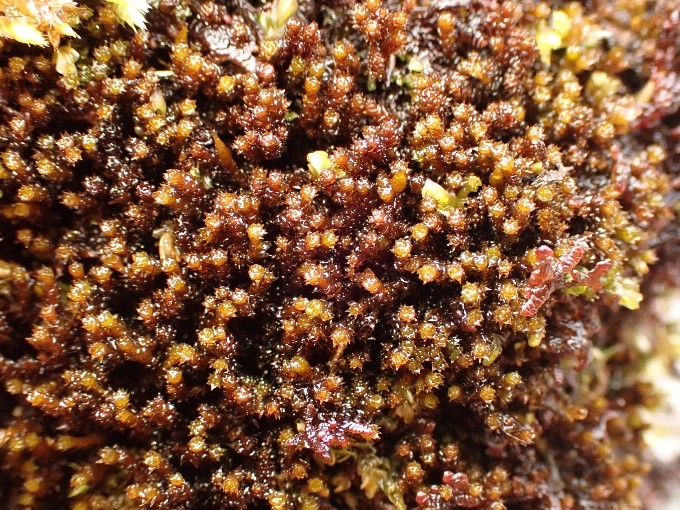Another blazing hot day was forecast, this time with the possibility of thunderstorms, so it wasn’t entirely surprising that I was the only bryologist that was up for the exposed slog up to Brown Cove in conditions where all the bryophytes would likely be too dessicated to identify. Fortunately there was a good lichen turnout and I was promised that there was some water still in Brown Cove, so we set off with hopeful hearts.
We hadn’t gone far before I spotted one of the papillose, Canescentia group of Racomitrium by the side of the track, which I later identified as R. elongatum. As we ascended the track there were small ditches and drainage channels running off the hillside which did indeed still have some water, and where Philonotis fontana, Dichodontium palustre and Scapania undulata flourished. We stopped for a water break – and to examine a large rock by the path – which had Andreaea rupestris and A. rothii, Racomitrium fasciculare and possible Racomitrium heterostichum. Sadly no Gymnomitrion, which surprisingly seemed to be absent from the whole site.
We passed the old dam and considered the enormous hole and the poor quality of the work as Pete told us the story of its very short life. The original dam, which seems to have been an earth barrier, was put up to provide electricity for the Greenside lead mine, but breached in a storm in 1927, causing extensive damage in Glenridding. It was replaced by the concrete dam which can be seen today in about 1929, but it seems to have failed almost immediately and the reservoir and dam were abandoned in 1931. A little beyond the dam we made our way down the earth bank of the original dam to the beck, which we then followed up to its source at the tarn in Brown Cove. The beck was bryophyte heaven, with huge mounds of golden Sciuro-hypnum plumosum and green Hygrohypnum ochraceum, with smaller amounts of Chionoloma tenuirostre, the ‘aromatic’ Jungermannia exsertifolia and some mounds of Amphidium mougeotii. Reaching the cove, we found that the tarn was a very shallow pool with green clumps of algae – I felt better about forgetting my swimming costume.
After a pleasant lunch we explored the edges of the tarn where rare lichens had previously been recorded. A rock on the edge had a sprawling moss which later turned out to be Antitrichia curtipendula – a nice find as it is a formerly (relatively) common moss which seems to be struggling. The ’grappling hook’ shaped teeth on the leaves are very distinctive.

I thought I’d make my way up the beck above the tarn, towards the ridge, in the hopes that higher altitude might bring more variety. However the species seemed to be mainly more of the same, though growing in abundance. There was a pleasant breeze though at this height, and there were ring ouzels calling, though I couldn’t see them. The flowering plants were also lovely – lots of Starry and Mossy saxifrage and Alpine ladies mantle. After pushing on for a while in the hopes that the next waterfall might bring something new, I eventually decided to call it a day and return to the lichenologists who were still at the tarn.
Checking my list of previous records I realised that there was one very interesting liverwort recorded just above the water level of the tarn – Porella obtusata. There are I think four records from Cumbria, all around Ullswater, but I’d never seen it before. I finally found it after completing a full tour of the lake, right below our lunch spot.
Porella obtusata – golden brown shoots with large, plane lobules a similar size to the underleaves:


Heading back down the beck I wanted to have a closer look at some large rocks I noticed on the way up, and was pleased to see Andreaea alpina and Anomodon julacea.

Andreaea alpina

Anomodon julacea growing in profusion with deceptively small Dichodontium pellucidum.
Although the thunderstorms hadn’t materialized, the heat was increasing as we descended into the valley, so some of us beat a hasty retreat and enjoyed a well-earned cold drink at the youth hostel bar. All in all, a very pleasant and rewarding day.
Text and photos: Clare Shaw
